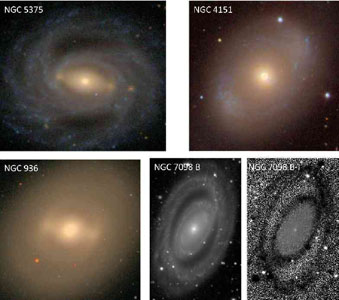NGC 7098: What Secrets Does This Mysterious Galaxy Hide?
Have you ever gazed up at the night sky and wondered about the countless galaxies swirling millions of light-years away? What stories do they hold? Here at FreeAstroScience.com, we love exploring these cosmic mysteries, and today, we're zooming in on a particularly fascinating one: NGC 7098. Welcome, fellow space enthusiasts! We invite you to join us on this journey as we unpack the unique features of this distant spiral galaxy. Stick with us till the end – you won't want to miss the intriguing details we've uncovered!
How Was NGC 7098 Discovered and Where Is It?
Let's travel back in time. On September 22, 1835, the brilliant British astronomer John Herschel spotted something new during his sky survey. That something was NGC 7098. Imagine the excitement of finding a whole new galaxy!
This celestial marvel resides in the southern Octans constellation, a staggering 95 million light-years from Earth. That distance is almost impossible to wrap your head around! NGC 7098 also goes by other names, like ESO 48-5 and PGC 67266.
Did You Know? The Octans constellation is home to Polaris Australis (Sigma Octantis), the Southern Hemisphere's equivalent of the North Star, though much fainter.
What Makes NGC 7098 Physically Unique?
NGC 7098 isn't just any spiral galaxy; it's a barred spiral galaxy with some truly special characteristics. Its galaxy structure is quite complex, making it a prime target for astronomers trying to understand galactic morphology.
How Big Is It, Really?
Based on its distance, we estimate NGC 7098 stretches about 152,000 light-years across. That's significantly larger than our own Milky Way galaxy! It's a true giant spinning out there in the cosmic dark.
!
Why Does It Have a Hazy Center?
Look towards the core, or nucleus, of NGC 7098, and you'll notice it appears somewhat fuzzy or hazy. This isn't just a blurry picture! Astronomers believe this haziness is because the galaxy's center lacks massive, bright stars and isn't currently undergoing vigorous star formation. It suggests a different stage in its life compared to galaxies with brilliant cores.
What About Its Rings and Bars?
Now for the really cool parts! NGC 7098 boasts some intriguing "double features":
- Double Ring-like Structures: Surrounding the hazy nucleus are what look like two rings. These are actually the galaxy's spiral arms, wound tightly around the core. Think of them like cosmic ribbons wrapping a gift.
- Double Bar Structure: Even more unusually, NGC 7098 seems to have two bar-like structures crossing its center. Bars are common in spiral galaxies (about two-thirds have them), acting like cosmic traffic directors, funneling gas and dust. But a double bar galaxy like NGC 7098? That's quite rare and offers clues about its internal gravitational interactions.
Key Takeaway: The double rings and double bars make NGC 7098 a fascinating case study for understanding how spiral galaxies evolve.
What Are Those Bright "Handles"? Understanding Ansae Structures
As if double rings and bars weren't enough, NGC 7098 also displays ansae structures. What on Earth are those? Imagine bright, handle-like blobs sticking out from the ends of the central bar region.
 An example diagram showing ansae structures (bright spots at bar ends) in barred galaxies. Credit: NED IPAC Caltech
An example diagram showing ansae structures (bright spots at bar ends) in barred galaxies. Credit: NED IPAC Caltech
These ansae (Latin for "handles") are areas of overdensity – basically, regions where stars or gas are packed more tightly. We see similar features in planetary nebulae, but finding them in a galaxy like NGC 7098 adds another layer to its complexity. They might be linked to how the bar shapes the galaxy over long periods.
Why Is Studying NGC 7098 Important?
You might be thinking, "Okay, it's cool, but why does it matter?" Studying galaxies like NGC 7098 helps us piece together the puzzle of the universe. Its unique features – the hazy nucleus, double rings, double bar, and ansae structures – provide vital clues about:
- How spiral galaxies form and change over billions of years.
- The role central bars play in shaping galaxy structure and driving star formation.
- The complex gravitational interactions happening within galaxies.
Every observation, like those from ESO's Very Large Telescope, adds a piece to this grand cosmic puzzle.
Peeking at NGC 7098 Yourself?
For our amateur astronomers in the Southern Hemisphere, observing NGC 7098 is a rewarding challenge. Located in the faint Octans constellation, you'll need a decent telescope (at least 6 inches aperture recommended) to catch a glimpse of this distant beauty. It's a reminder of the vast, intricate universe waiting to be explored.
Our Final Thoughts on NGC 7098
So, what have we learned? NGC 7098 isn't just another spiral galaxy; it's a unique cosmic laboratory showcasing rare features like double bars and ansae. It challenges our understanding of galactic morphology and evolution. From its discovery by John Herschel to modern observations, NGC 7098 continues to fascinate us.
Here at FreeAstroScience.com, we believe that understanding these distant wonders brings us closer to understanding our own place in the cosmos. NGC 7098 reminds us that the universe is full of surprises, complexity, and breathtaking beauty, still holding secrets waiting to be unveiled. What mysteries do you think galaxies like NGC 7098 still hold? Keep looking up!


Post a Comment